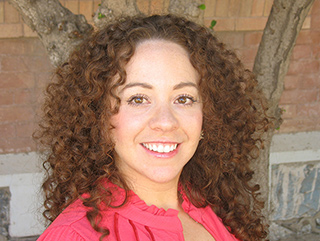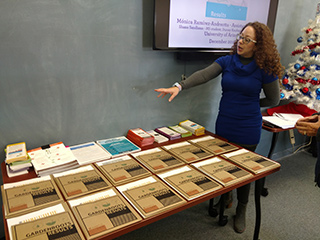February 17, 2022
With NIEHS support, Mónica Ramírez-Andreotta, Ph.D., uses participatory methods to build environmental health literacy and involve communities to translate research into action.

Mónica Ramírez-Andreotta, Ph.D., a former NIEHS-funded trainee at the University of Arizona Superfund Research Program (SRP) Center, now leads research translation activities by the center to communicate and apply scientific findings to address critical environmental health problems in communities affected by hazardous contaminants.
“Growing in up Tucson, home to the Tohono O'odham and Yaqui tribes, in the Arizona-Mexico border region, with family in both countries, I witnessed social and environmental degradation, and how this affected the well-being of communities,” Ramírez-Andreotta reflected. “Seeing multiple forms of knowledge and expertise in my family and community, shaped the way I see environmental health research.
Engaging Communities in Science
In 2008, Ramírez-Andreotta launched Gardenroots, a community science project in partnership with residents of Dewey-Humboldt, Arizona.
“After a Superfund site was listed in the community, I attended a meeting where residents expressed their concerns about the potential impacts on their soil and community gardens,” explained Ramírez-Andreotta. “Community gardens have the potential to increase access to wholesome foods, create green space, and improve well-being, especially in remote areas. The residents wanted to know if they could still eat the vegetables they were growing.”

Ramírez-Andreotta and team trained community members to collect soil, water, and plant samples from their home gardens to evaluate metal(loid) exposure, with an emphasis on arsenic and potential risks from vegetable consumption. Together, they found that, in general, arsenic concentrations were higher in vegetables grown in gardens in the area than store-brought produce.
“Residents wanted to know more about what is in their soil, air, and water,” said Ramírez-Andreotta. “We conduct trainings and distribute user-friendly sampling kits, along with instructions in their preferred language. We run the samples, interpret the data, create visualizations to effectively communicate personalized results, and share strategies to reduce exposure while still enjoying gardening.”
Building on the success of the project in Dewey-Humboldt, Ramírez-Andreotta expanded Gardenroots into a nationwide initiative to evaluate environmental quality in residential and community gardens.
For example, based on a partnership established with the Concerned Citizens and Retired Miners Coalition of Superior, Arizona, Ramírez-Andreotta and community leaders worked with families near abandoned mines to implement Gardenroots and determine residential environmental quality. One component of this work was to use plants to monitor metals in air.
Integrating Data
According to Ramírez-Andreotta, integrating datasets from community scientists, research institutions, and state and federal agencies can help answer existing and new questions about environmental public health. Through the University of Arizona SRP Center, Ramírez-Andreotta and collaborators sought to overcome the many challenges of integrating and reusing data from different sources.
“Community members are devoting time and energy to conducting research, co-generating datasets, and translating findings,” she explained. “Aligning with research ethics, we need to make sure we standardize our data and make it reusable, so that we can inform systematic change to alleviate health disparities.”
The team developed a methodology to integrate community data with federal and state datasets, laying the groundwork for more widespread use of community data. They successfully combined multiple datasets, which included environmental, health, political, and social factors, such as access to parks, healthcare coverage, and linguistic isolation.
Early Training Years
Ramírez-Andreotta kicked off her NIEHS career working as the research translation coordinator at the University of Arizona SRP Center.
“SRP acknowledged my diverse skillset and opened the doors to working with people across different disciplines, building partnerships with communities, and translating research into action, and that’s really what inspired me to pursue a doctoral degree as an SRP trainee in the program,” said Ramírez-Andreotta.
Under the guidance of University of Arizona SRP Center researchers Mark Brusseau, Ph.D., and Raina Maier, Ph.D., Ramírez-Andreotta integrated environmental science research and visual communication design and kicked off the Gardenroots project.
“I’m thankful to the wonderful mentors I had as an SRP trainee who inspired me to pursue this career,” Ramírez-Andreotta reflected. “Back then I had a lot of ideas, but I also had the right people around me. Drs. Maier, Brusseau, and others at the University of Arizona saw something in me that I didn’t see in myself at all. Together, they supported my ideas and gumption.”
While wrapping up her doctoral degree, Ramírez-Andreotta received the 2011 SRP Karen Wetterhahn Award. She was recognized for her commitment to engaging community members in research and communicating study results to help individuals make informed actions to protect their health.
In addition to support from NIEHS, Ramírez-Andreotta received a grant from the U.S. Environmental Protection Agency’s Office of Research and Development and was a recipient of the Alfred P. Sloan Foundation’s National Action Council for Minorities in Engineering Scholarship. She also received fellowships from the University of Arizona’s Graduate Access Tuition Award and Water Sustainability Program and from the NASA National Space Grant.


